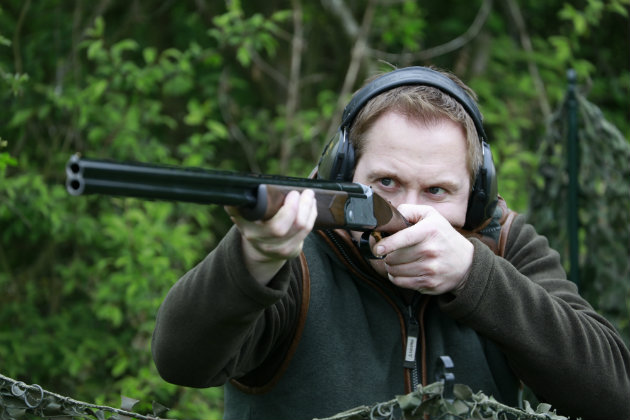Looking at a 28-bore shotgun and cartridges
Charles Bull performs an experiment ...

Taking aim with a 28-bore Cogswell & Harrison shotgun
A good shot and friend of mine has been invited to shoot stupidly high birds on a commercial pheasant shoot where the headkeeper is a little sniffy about any cartridge that doesn’t carry at least 1.1/4oz (36gms) of big lead pellets in a plastic wad.
Even my mate’s other friends have recommended he uses Express 3in 50gm 3s.
28-bore addict
The trouble is, like me, he’s a confirmed 28-bore addict and wants to use it on the day.
Peoples’ perception of what is and what isn’t a high bird can be worlds apart but while I like to shoot testing pheasants I also like to see them being killed cleanly.
There is no pleasure in seeing a picker up walking in from half a mile away with half a dozen pheasants, saying: “Well shot Sir,” when I didn’t realise I had hit any. There is no satisfaction in this whatsoever, and my friend shares that view.
So should he take his 28-bore with full choke 32 inch barrels?
The heavier the load the more powerful?
There’s a common belief that the heavier the load, the more powerful it is. This is rubbish. A heavier load just gives you more pellets in the pattern and, theoretically, more chance of hitting the mark.
This, however, depends on how the pattern performs at 70 yards or more with large shot, and I would guess it would not be too hot.
The larger pellet will deliver more striking energy, whereas a smaller pellet will give better penetration. So an optimum size, giving the best of both worlds, is what we should look for.
In terms of ballistics, heavier loads will often be slower than their lighter brothers. For the purposes of this test, we will assume that the two products we are using are on a par, namely Express Maximum Game Magnum 50gm 3s and Winchester 28-bore 1 oz (28gm) US 6 shot (about English 5). Their speeds are virtually the same at around 1375fps and the size of shot is about 0.5mm different with the UK 3s measuring 3.3mm compared to the US 6 at 2.8mm.
Starting the experiment
I was banking on the 28-bore throwing a better pattern to outperform the heavier twelve.
- First thing first though. The 50gm load of 3 shot delivered an average pellet count of 303 and the 1oz 28-bore, 229, 25% less.
- We decided to get straight on with the test by firing at a painted hardboard pattern plate 75 yards away.
- The 28-bore managed on average to put 49 pellets on the target (21.4% of its payload) while the 12-bore weighed in with only 43 pellets (14.2%). No worries with pattern then, but what about penetration?
- We found it hard to differentiate between the two, both seemed to penetrate to equivalent depth. The greater kinetic energy of the larger pellet let it penetrate as much as the smaller pellet, so no worries here either.
- Just for something to do, we then decided to test the loads on a seven inch disc (effective target area of a pheasant) at 25 yards.
- Pellet count for the 28-bore was a convincing 40 on such a small target and a paltry 19 with the 12-bore load.
- Again, penetration was very similar – as it was at 35 yards – a commoner range for pheasant shooting.
Kofs Sceptre SXE 28-bore
Over the last few months I have been hearing and seeing a lot of questions arising around Kofs shotguns. So,…
Rizzini Artemis 28-bore shotgun review
Rizzini Artemis 28-bore shotgun: This Rizzini Artemis 28-bore shotgun is an elegant yet functional Italian shotgun.
28-bore shotgun cartridges
28-bore shotgun cartridges: Be you a game or clay shooter – take a look at the different cartridges available for…
CONCLUSION
This, I admit, is an entirely unscientific experiment but it has merely proved what I have always believed to be true – a 28-bore gun will always throw a better pattern than a 12-bore, and you need a good pattern to kill your quarry.
The only advice I will offer is that if you are shooting at extreme range, then get the largest shot size you can, which is likely to be a UK 5.
The only other consideration here is recoil. My pal is a big bloke, but he really didn’t enjoy blatting away with the 50gm magnum load he was sent.
On a high bird shoot you need to fire a fair few shots to get your bag, so physical punishment according to Newton’s Third Law of Motion is going to be considerable and may detract from your enjoyment of the day.
Some may say that a 1oz load through a 28-bore might cause a similar problem but as long as you use a heavy-ish gun to soak up the recoil you shouldn’t have a problem.
I can fire these loads all day long without discomfort.
The downside? Well you are going to miss more as you need to be 100% more accurate with a 28 than with a 12-bore. As long as this doesn’t bother you, you should find shooting a more fulfilling experience as a result and that’s what it’s all about surely?











